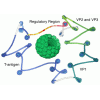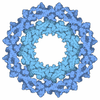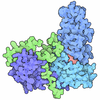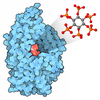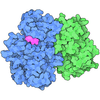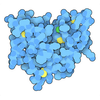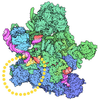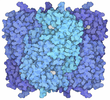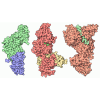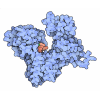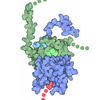| 登録情報 | データベース: PDB / ID: 3k7v
|
|---|
| タイトル | Protein phosphatase 2A core complex bound to dinophysistoxin-1 |
|---|
 要素 要素 | (Serine/threonine-protein phosphatase 2A ...) x 2 |
|---|
 キーワード キーワード | SIGNALING PROTEIN/HYDROLASE / PROTEIN-PROTEIN COMPLEX / HEAT REPEAT / SIGNALING PROTEIN / PHOSPHATASE / LIGAND SPECIFICITY / Acetylation / Polymorphism / Centromere / Cytoplasm / Cytoskeleton / Hydrolase / Iron / Manganese / Metal-binding / Methylation / Nucleus / Phosphoprotein / Protein phosphatase / SIGNALING PROTEIN-HYDROLASE complex |
|---|
| 機能・相同性 |  機能・相同性情報 機能・相同性情報
meiotic spindle elongation / Integration of energy metabolism / PP2A-mediated dephosphorylation of key metabolic factors / RNA polymerase II CTD heptapeptide repeat S2 phosphatase activity / RNA polymerase II CTD heptapeptide repeat S7 phosphatase activity / MASTL Facilitates Mitotic Progression / protein phosphatase type 2A complex / protein serine/threonine phosphatase complex / peptidyl-threonine dephosphorylation / regulation of meiotic cell cycle process involved in oocyte maturation ...meiotic spindle elongation / Integration of energy metabolism / PP2A-mediated dephosphorylation of key metabolic factors / RNA polymerase II CTD heptapeptide repeat S2 phosphatase activity / RNA polymerase II CTD heptapeptide repeat S7 phosphatase activity / MASTL Facilitates Mitotic Progression / protein phosphatase type 2A complex / protein serine/threonine phosphatase complex / peptidyl-threonine dephosphorylation / regulation of meiotic cell cycle process involved in oocyte maturation / mitotic sister chromatid separation / meiotic sister chromatid cohesion, centromeric / INTAC complex / RNA polymerase II CTD heptapeptide repeat S5 phosphatase activity / FAR/SIN/STRIPAK complex / Regulation of glycolysis by fructose 2,6-bisphosphate metabolism / Inhibition of replication initiation of damaged DNA by RB1/E2F1 / female meiotic nuclear division / protein phosphatase regulator activity / GABA receptor binding / APC truncation mutants have impaired AXIN binding / AXIN missense mutants destabilize the destruction complex / Truncations of AMER1 destabilize the destruction complex / protein antigen binding / ERKs are inactivated / positive regulation of extrinsic apoptotic signaling pathway in absence of ligand / Initiation of Nuclear Envelope (NE) Reformation / Beta-catenin phosphorylation cascade / Signaling by GSK3beta mutants / CTNNB1 S33 mutants aren't phosphorylated / CTNNB1 S37 mutants aren't phosphorylated / CTNNB1 S45 mutants aren't phosphorylated / CTNNB1 T41 mutants aren't phosphorylated / RNA polymerase II transcription initiation surveillance / Co-stimulation by CD28 / regulation of growth / Disassembly of the destruction complex and recruitment of AXIN to the membrane / negative regulation of epithelial to mesenchymal transition / Co-inhibition by CTLA4 / Platelet sensitization by LDL / protein-serine/threonine phosphatase / negative regulation of glycolytic process through fructose-6-phosphate / positive regulation of NLRP3 inflammasome complex assembly / ERK/MAPK targets / protein serine/threonine phosphatase activity / mesoderm development / vascular endothelial cell response to oscillatory fluid shear stress / T cell homeostasis / regulation of cell differentiation / regulation of microtubule polymerization / phosphoprotein phosphatase activity / regulation of G1/S transition of mitotic cell cycle / lateral plasma membrane / chromosome, centromeric region / DARPP-32 events / negative regulation of hippo signaling / protein dephosphorylation / Nonsense Mediated Decay (NMD) enhanced by the Exon Junction Complex (EJC) / Cyclin A/B1/B2 associated events during G2/M transition / spindle assembly / Amplification of signal from unattached kinetochores via a MAD2 inhibitory signal / Loss of Nlp from mitotic centrosomes / Loss of proteins required for interphase microtubule organization from the centrosome / Mitotic Prometaphase / Recruitment of mitotic centrosome proteins and complexes / EML4 and NUDC in mitotic spindle formation / negative regulation of phosphatidylinositol 3-kinase/protein kinase B signal transduction / Recruitment of NuMA to mitotic centrosomes / protein tyrosine phosphatase activity / Anchoring of the basal body to the plasma membrane / Resolution of Sister Chromatid Cohesion / Turbulent (oscillatory, disturbed) flow shear stress activates signaling by PIEZO1 and integrins in endothelial cells / AURKA Activation by TPX2 / meiotic cell cycle / chromosome segregation / RAF activation / Spry regulation of FGF signaling / RHO GTPases Activate Formins / negative regulation of canonical Wnt signaling pathway / PKR-mediated signaling / Degradation of beta-catenin by the destruction complex / response to lead ion / tau protein binding / spindle pole / Negative regulation of MAPK pathway / Cyclin D associated events in G1 / Separation of Sister Chromatids / Regulation of TP53 Degradation / Regulation of PLK1 Activity at G2/M Transition / mitotic cell cycle / microtubule cytoskeleton / PI5P, PP2A and IER3 Regulate PI3K/AKT Signaling / protein-containing complex assembly / neuron projection / intracellular signal transduction / membrane raft / protein heterodimerization activity / neuronal cell body / synapse / dendrite類似検索 - 分子機能 : / : / HEAT repeat / HEAT repeat / : / PPP2R1A-like HEAT repeat / Serine/threonine specific protein phosphatases signature. / Protein phosphatase 2A homologues, catalytic domain. / Serine/threonine-specific protein phosphatase/bis(5-nucleosyl)-tetraphosphatase / HEAT repeat profile. ...: / : / HEAT repeat / HEAT repeat / : / PPP2R1A-like HEAT repeat / Serine/threonine specific protein phosphatases signature. / Protein phosphatase 2A homologues, catalytic domain. / Serine/threonine-specific protein phosphatase/bis(5-nucleosyl)-tetraphosphatase / HEAT repeat profile. / HEAT, type 2 / HEAT repeats / Metallo-dependent phosphatases / Purple Acid Phosphatase; chain A, domain 2 / Calcineurin-like phosphoesterase domain, ApaH type / Calcineurin-like phosphoesterase / Leucine-rich Repeat Variant / Leucine-rich Repeat Variant / Metallo-dependent phosphatase-like / 4-Layer Sandwich / Armadillo-like helical / Alpha Horseshoe / Armadillo-type fold / Mainly Alpha / Alpha Beta類似検索 - ドメイン・相同性 : / Chem-XT1 / Serine/threonine-protein phosphatase 2A 65 kDa regulatory subunit A alpha isoform / Serine/threonine-protein phosphatase 2A catalytic subunit alpha isoform類似検索 - 構成要素 |
|---|
| 生物種 |  Homo sapiens (ヒト) Homo sapiens (ヒト) |
|---|
| 手法 |  X線回折 / X線回折 /  シンクロトロン / Rigid body refinement / 解像度: 2.85 Å シンクロトロン / Rigid body refinement / 解像度: 2.85 Å |
|---|
 データ登録者 データ登録者 | Jeffrey, P.D. / Huhn, J. / Shi, Y. |
|---|
 引用 引用 |  ジャーナル: Chem.Res.Toxicol. / 年: 2009 ジャーナル: Chem.Res.Toxicol. / 年: 2009
タイトル: A structural basis for the reduced toxicity of dinophysistoxin-2.
著者: Huhn, J. / Jeffrey, P.D. / Larsen, K. / Rundberget, T. / Rise, F. / Cox, N.R. / Arcus, V. / Shi, Y. / Miles, C.O. |
|---|
| 履歴 | | 登録 | 2009年10月13日 | 登録サイト: RCSB / 処理サイト: RCSB |
|---|
| 改定 1.0 | 2009年11月3日 | Provider: repository / タイプ: Initial release |
|---|
| 改定 1.1 | 2011年7月13日 | Group: Version format compliance |
|---|
| 改定 1.2 | 2023年9月6日 | Group: Data collection / Database references ...Data collection / Database references / Derived calculations / Refinement description
カテゴリ: chem_comp_atom / chem_comp_bond ...chem_comp_atom / chem_comp_bond / database_2 / pdbx_initial_refinement_model / pdbx_struct_conn_angle / struct_conn / struct_site
Item: _database_2.pdbx_DOI / _database_2.pdbx_database_accession ..._database_2.pdbx_DOI / _database_2.pdbx_database_accession / _pdbx_struct_conn_angle.ptnr1_auth_comp_id / _pdbx_struct_conn_angle.ptnr1_auth_seq_id / _pdbx_struct_conn_angle.ptnr1_label_atom_id / _pdbx_struct_conn_angle.ptnr1_label_comp_id / _pdbx_struct_conn_angle.ptnr1_label_seq_id / _pdbx_struct_conn_angle.ptnr2_auth_seq_id / _pdbx_struct_conn_angle.ptnr2_label_asym_id / _pdbx_struct_conn_angle.ptnr3_auth_comp_id / _pdbx_struct_conn_angle.ptnr3_auth_seq_id / _pdbx_struct_conn_angle.ptnr3_label_atom_id / _pdbx_struct_conn_angle.ptnr3_label_comp_id / _pdbx_struct_conn_angle.ptnr3_label_seq_id / _pdbx_struct_conn_angle.value / _struct_conn.pdbx_dist_value / _struct_conn.ptnr1_auth_comp_id / _struct_conn.ptnr1_auth_seq_id / _struct_conn.ptnr1_label_atom_id / _struct_conn.ptnr1_label_comp_id / _struct_conn.ptnr1_label_seq_id / _struct_conn.ptnr2_auth_seq_id / _struct_conn.ptnr2_label_asym_id / _struct_site.pdbx_auth_asym_id / _struct_site.pdbx_auth_comp_id / _struct_site.pdbx_auth_seq_id |
|---|
|
|---|
 データを開く
データを開く 基本情報
基本情報 要素
要素 キーワード
キーワード 機能・相同性情報
機能・相同性情報 Homo sapiens (ヒト)
Homo sapiens (ヒト) X線回折 /
X線回折 /  シンクロトロン / Rigid body refinement / 解像度: 2.85 Å
シンクロトロン / Rigid body refinement / 解像度: 2.85 Å  データ登録者
データ登録者 引用
引用 ジャーナル: Chem.Res.Toxicol. / 年: 2009
ジャーナル: Chem.Res.Toxicol. / 年: 2009 構造の表示
構造の表示 Molmil
Molmil Jmol/JSmol
Jmol/JSmol ダウンロードとリンク
ダウンロードとリンク ダウンロード
ダウンロード 3k7v.cif.gz
3k7v.cif.gz PDBx/mmCIF形式
PDBx/mmCIF形式 pdb3k7v.ent.gz
pdb3k7v.ent.gz PDB形式
PDB形式 3k7v.json.gz
3k7v.json.gz PDBx/mmJSON形式
PDBx/mmJSON形式 その他のダウンロード
その他のダウンロード 3k7v_validation.pdf.gz
3k7v_validation.pdf.gz wwPDB検証レポート
wwPDB検証レポート 3k7v_full_validation.pdf.gz
3k7v_full_validation.pdf.gz 3k7v_validation.xml.gz
3k7v_validation.xml.gz 3k7v_validation.cif.gz
3k7v_validation.cif.gz https://data.pdbj.org/pub/pdb/validation_reports/k7/3k7v
https://data.pdbj.org/pub/pdb/validation_reports/k7/3k7v ftp://data.pdbj.org/pub/pdb/validation_reports/k7/3k7v
ftp://data.pdbj.org/pub/pdb/validation_reports/k7/3k7v リンク
リンク 集合体
集合体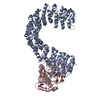
 要素
要素 Homo sapiens (ヒト) / 遺伝子: PPP2R1A / プラスミド: PGEX-2T / 発現宿主:
Homo sapiens (ヒト) / 遺伝子: PPP2R1A / プラスミド: PGEX-2T / 発現宿主: 
 Homo sapiens (ヒト) / 遺伝子: PPP2CA
Homo sapiens (ヒト) / 遺伝子: PPP2CA
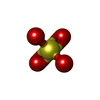
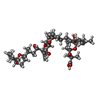





 X線回折 / 使用した結晶の数: 1
X線回折 / 使用した結晶の数: 1  試料調製
試料調製 シンクロトロン / サイト:
シンクロトロン / サイト:  NSLS
NSLS  / ビームライン: X29A / 波長: 1.0809 Å
/ ビームライン: X29A / 波長: 1.0809 Å 解析
解析 ムービー
ムービー コントローラー
コントローラー




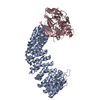

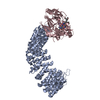
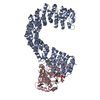
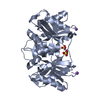
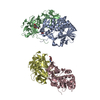
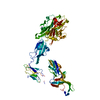

 PDBj
PDBj

